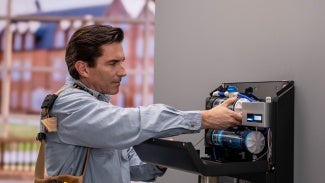5 reasons drinking water should factor into your design
AIA partner Elkay explores how innovative water solutions are transforming architectural spaces.
Water delivery options have evolved far beyond code compliance. Today's building occupants demand safer drinking water with advanced filtration, while owners pursue aggressive sustainability benchmarks and reduced operational costs. As water quality awareness rises, architects must intentionally integrate solutions that address shifting priorities while adhering to their design vision.
The good news is contemporary bottle filling stations are redefining water delivery to meet these challenges with the most powerful filtration yet. These systems feature bolder architecture, advanced technology, and unique features that simplify maintenance. As a result, a utilitarian necessity transforms into a design feature that delivers measurable benefits to building owners and occupants alike.
Here are five ways drinking water delivery can impact design.
1. People expect filtration
Today's consumers increasingly carry reusable water bottles filled with filtered water as awareness of contaminants like lead and PFAS continues to grow. For architects, this translates directly to specification requirements that address health concerns and compliance standards.
Michigan's 2023 Filter First legislation exemplifies this shift in priorities, mandating lead-reducing filters in schools and childcare facilities. This regulatory trend, likely to expand nationally, requires architects to anticipate filtration needs early in the design process. According to the EPA, even low levels of lead exposure can impact children's behavior and development, and it is linked to reproductive issues in adults—making water quality an essential consideration in building safety.
PFAS are synthetic chemicals used in a variety of manufactured products. These chemicals can end up in our water when spilled into the environment. According to a study funded by the National Institutes of Health, PFAS have been found in 45% of U.S. drinking water supplies. Another study detected PFAS in 39% of tested bottled water. As municipalities adopt stricter standards for these contaminants, architects must design with flexibility for evolving filtration requirements.
For successful projects, architects should specify certified point-of-use filtration systems from reputable manufacturers that address these contaminants as part of their overall design vision. This proactive approach satisfies both current regulations and can help future-proof against emerging water quality concerns.

2. Bottle filling stations contribute to sustainability
Giving clients access to water through a bottle filling station helps reduce the need for disposable plastic bottles. As an example, 15 Elkay bottle filling stations save 1,890,000 plastic bottles over their lifetime, which provides a measurable metric owners can showcase in their sustainability reports and ESG disclosures. For architects and designers, these installations offer multiple benefits: They contribute points toward LEED, WELL, and other green building certifications; they demonstrate a commitment to reducing plastic waste; and they serve as tangible evidence of a project's sustainability values.
This alignment of environmental goals and certification requirements makes bottle filling stations an essential component of forward-thinking designs across education buildings, corporate offices, and public spaces.
3. Drinking water upgrades are now easier
Upgrading fountains and coolers to filtered bottle-filling stations used to present design challenges. The only viable approach was installation during new builds, limiting renovation options for existing structures. Today’s simplified retrofit options have opened the door to remodels and subtle facelifts without extensive demolition. Many modern retrofit units are engineered with universal rough-in dimensions that match legacy installations, allowing for direct replacements that minimize the need for wall repairs and maintain design integrity.
These upgrades deliver compelling benefits that architects can highlight to clients: enhanced occupant satisfaction through safer drinking water, fewer maintenance requirements than previous models, and improved aesthetics that complement many design styles.
4. Significant cost savings
When architects can present pioneering design and substantial financial benefits, client approval accelerates dramatically. Filtered bottle filling stations deliver compelling ROI through multiple avenues: elimination of recurring bottled water and jug purchases, reduced energy and water consumption costs, and minimized labor costs.
For projects in challenging water-quality environments, architects can now specify sophisticated multi-stage filtration designs. Pairing primary filters with sediment prefilters is key in areas with high sediment levels. This two-stage process prevents sediment buildup on primary filters so that they can last their full life, keeping filter purchases at a minimum. Equally important for maintenance teams is the improved serviceability—innovative filter access at the top eliminates the awkward maintenance positions required by older units. As one Wisconsin MEP associate explains, "Filter access at the top is a home run for me and the maintenance teams, whose input means a lot to me."
These thoughtful design improvements may directly translate to higher client satisfaction and stronger endorsements for future projects.

5. It comes with bells and whistles
Bottle filling stations have evolved into design statements with sleeker, more attractive aesthetics that architects can intentionally incorporate into their earliest conceptual phases. Much like selecting signature lighting or premium hardware, these sophisticated units offer distinctive options with premium finishes, modern color palettes and sculptural silhouettes that complement diverse design styles, from minimalist to industrial.
Brand recognition provides an additional benefit, as established manufacturers bring built-in user confidence that enhances the overall experience. One such enhancement is the integration of IoT-enabled smart monitoring systems that provide real-time data on usage patterns, filter life, and sustainability metrics.
The evolution of drinking water access
Water delivery has evolved dramatically, with today's bottle filling stations offering unprecedented benefits beyond basic functionality. Innovative technology, elevated aesthetics, and new levels of filtration make incorporating bottle filling stations into your designs more intuitive than ever before. They enable you to address evolving health and sustainability requirements while creating distinctive spaces that deliver measurable benefits for building owners and occupants.
Elkay is proud to innovate in an era where water delivery is influencing design. Visit elkay.com to see how the drinking water landscape is changing and discover solutions for your next project.
AIA does not sponsor or endorse any enterprise, whether public or private, operated for profit. Further, no AIA officer, director, committee member, or employee, or any of its component organizations in his or her official capacity, is permitted to approve, sponsor, endorse, or do anything that may be deemed or construed to be an approval, sponsorship, or endorsement of any material of construction or any method or manner of handling, using, distributing, or dealing in any material or product.
